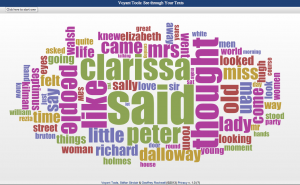I often assign literary analyses that ask students to work with data visualization tools such as Wordle, Prezi, Google Maps, Voyant, and Many Eyes. While it’s fun to play around with literary texts in word clouds and word trees, it is much more difficult to use visualizations for an effective “distant reading” to use Franco Moretti’s term. In the brand new online MLA Commons publication Literary Studies in the Digital Age, Tanya Clement writes in the chapter on “Text Analysis, Data Mining, and Visualizations in Literary Scholarship”:
These [data visualization] methodologies defamiliarize texts, making them unrecognizable in a way (putting them at a distance) that helps scholars identify features they might not otherwise have seen, make hypotheses, generate research questions, and figure out prevalent patterns and how to read them.
I imagine this session as a combined Talk/Play session in which we discuss the benefits and pitfalls of using data visualizations in the literature classroom (and in our own research) and play with some of these tools to see if we can come up with new hypotheses, research questions, and interpretations of patterns. I’d also be happy to share what I learned about Voyant at this week’s DiSC workshop.




2 pings
THATCampSE 2013 at Georgia Tech: Literary Analysis & Data Visualization Tools | Dynamic Subspace
March 9, 2013 at 4:01 pm (UTC 0) Link to this comment
[…] THATCampSE 2013 at Georgia Tech: Literary Analysis & Data Visualization Tools […]
Recent and Upcoming Events | Doris Bremm PhD
March 10, 2013 at 6:50 pm (UTC 0) Link to this comment
[…] and led sessions on Literary Analysis & Data Visualization Tools. Session One: Voyant Workshop. Session Two: Discussion of Assignments and Compilation of a list of […]